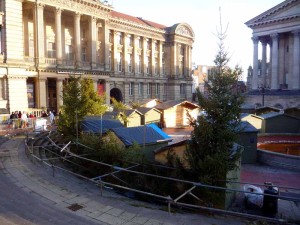Birmingham’s German Market was a great success but Alan Clawley laments its setting.
Whether or not the supporters of the German Market know the exact number of extra people who thronged Birmingham’s shopping streets in the run-up to Christmas, there is no doubt that it is a big attraction.
This year I noticed that some structures have evolved from single storey garden sheds to multi-storey alpine chalets and gothic skyscrapers. Some look as if they were built centuries ago from rough-hewn timber and one shed appeared to have been patched up with old bricks and corrugated iron to show its age. It is of course all made of fibreglass (or, more likely, recycled plastic, knowing its origin in Germany), but no-one seems to care. The Disney-like set, along with its props, provides a brief means of escape from and within the ‘modernist’ city.
Urban people have always expressed their unhappiness in ways that ranged from the high-minded to the visceral to the outright violent ever since Britain became the first industrialised nation. William Morris and the Pre-Raphaelites harked back to a lost age of chivalry, craftsmanship and village life but found that only the wealthy minority could afford to buy their work. They lived in one-off houses designed by architects that imitated a mediaeval hand-built world.
There are of course still a few cities in England that could have offered a setting more like the old town square and riverside quays where the original Frankfurt market is held, but Birmingham, as always, wants to have the biggest and best regardless of whether it’s the right place for it.
Mainland Europe is still rich in historic town squares because they were faithfully rebuilt after being destroyed in World War Two – sometimes from old Canaletto paintings – rather than replaced with modern precincts like Coventry. Birmingham’s old centre is of course occupied by the steel sheds of the Wholesale Markets and has no town square at all, ancient or modern, in which to hold big fairs.
And now even the doctrine of Modernism that drove Coventry’s town planners to finish the work started by the Luftwaffe, is, according to Charles Jenks, history too. He wrote, ‘since it is fairly dead, we might as well enjoy picking over the corpse’. It’s replacement, ‘Post-Modernism’, is nigh on impossible to define, although the Victoria and Albert Museum makes a sporting attempt to do so in its current show, ‘Postmodernism – Style and Subversion, 1970-1990’, even noting the part that German Markets played in its evolution.
High art appeals to a small minority of the population while life goes on in much the same way for the masses. Modern industrial cities can’t be rebuilt wholesale like mediaeval settlements – it’s impossible to imagine Birmingham being redesigned in the style of the Old Crown, the sole remnant of the city’s mediaeval past. Neither, as William Morris came to realise, can we all go back to weaving our own clothes on hand looms in the attic. So, for those that need an annual dose of escapism it looks like we will have to put up with an even bigger, taller and more crowded German Market next Christmas.



